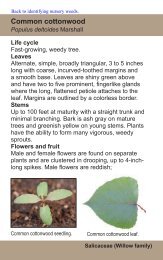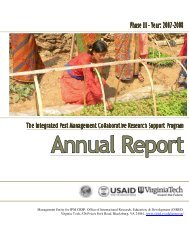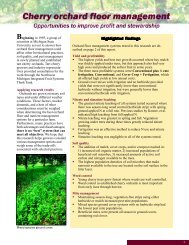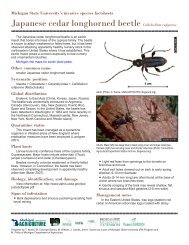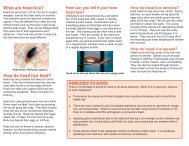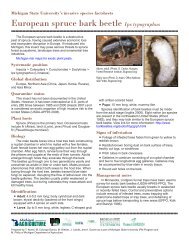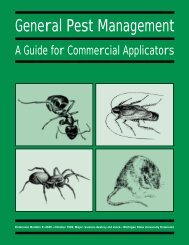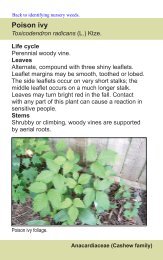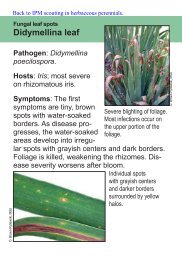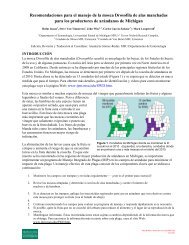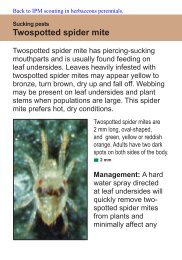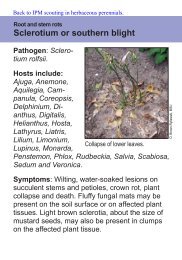Whole Manual - Michigan State University: Integrated Pest ...
Whole Manual - Michigan State University: Integrated Pest ...
Whole Manual - Michigan State University: Integrated Pest ...
Create successful ePaper yourself
Turn your PDF publications into a flip-book with our unique Google optimized e-Paper software.
down into the crown and eventually into the carrot, and<br />
feed for two to four weeks. Larvae pupate in the soil, and<br />
adults begin to emerge in mid-June. Alternate hosts<br />
include celery, parsley, Queen Anne’s lace, and some<br />
broadleaf weeds.<br />
■ Monitor carrot weevil populations with traps baited<br />
with carrot. If pesticide applications are made, they<br />
can be targeted toward newly hatched larvae with a<br />
systemic insecticide or toward molts using a standard<br />
insecticide in the spring or early summer when the<br />
adults are active. See Extension bulletin E-890,<br />
Detection and Control of Carrot Weevil, for detailed<br />
information on trapping.<br />
INSECT PESTS OF CELERY<br />
Aster leafhoppers and carrot weevils can also attack<br />
celery. Please refer to the carrot insect section for information<br />
about these pests.<br />
Adult carrot weevils do not fly.<br />
Damage: Adult carrot weevils do not cause serious damage<br />
to carrots. They feed on foliage, making small holes<br />
in leaf petioles. However, carrot weevil larvae feed by<br />
tunneling in the upper third of the carrot, making the carrot<br />
unmarketable for either fresh or processing. Carrot<br />
weevil tunnels also create a route of entry for secondary<br />
infections by plant pathogens.<br />
Control strategies:<br />
■ Practice crop rotation with non-host crops, such as<br />
onions or potatoes. This provides control because<br />
adult carrot weevils do not fly.<br />
■ Control alternate weed hosts (e.g., Queen Anne’s lace,<br />
plantain).<br />
APHIDS<br />
Green Peach Aphid (Myzus persicae) and<br />
Sunflower Aphid (Aphis helianthi)<br />
Aphids are generally characterized by a pear-shaped<br />
body with two cornicles or “tailpipes” on the hind end.<br />
Adult green peach aphids may vary in color from yellow<br />
to light green to pink. Sunflower aphids are green with<br />
black cornicles and black legs. There are wingless and<br />
winged forms of both aphids. Winged green peach aphids<br />
have dark patches on the head, thorax and abdomen.<br />
Adult female aphids reproduce without mating, creating<br />
genetically identical offspring. They do not lay eggs<br />
but give birth to tiny aphids. Aphids overwinter as eggs<br />
on host plants or as adults in greenhouses. They also<br />
migrate into <strong>Michigan</strong> from the southern United <strong>State</strong>s.<br />
There are five to ten generations per year.<br />
Damage: Aphids use their sucking mouthparts to drink<br />
plant sap and also transmit viruses. Aphid damage can<br />
twist and distort new plant growth, and aphids can contaminate<br />
the harvested product.<br />
Control strategies:<br />
■ Aphids have many natural enemies; lady beetles,<br />
lacewings, spiders, parasitic wasps, and fungal diseases<br />
help maintain low aphid populations.<br />
■ Chemical control for aphids is not usually necessary<br />
unless other pesticide applications have eliminated all<br />
natural enemies. Aphids can rapidly develop pesticide<br />
resistance because aphid offspring are genetically<br />
identical.<br />
CELERY LOOPER (Syngrapha falcifera)<br />
CABBAGE LOOPER (Trichoplusia ni)<br />
Celery and cabbage looper larvae are green caterpillars<br />
with white stripes on their sides and are up to one<br />
inch long. The larvae move like inchworms, bringing<br />
their back legs forward and creating a loop with their<br />
body. Celery loopers overwinter in <strong>Michigan</strong> as pupae<br />
and emerge as adults in May. Cabbage loopers migrate<br />
into <strong>Michigan</strong> from the southern United <strong>State</strong>s in late<br />
June to early July. The adult moths lay white, round eggs<br />
about the size of a pinhead. The larvae feed for approxi-<br />
Chapter 5<br />
36<br />
Vegetable Crop <strong>Pest</strong> Management



